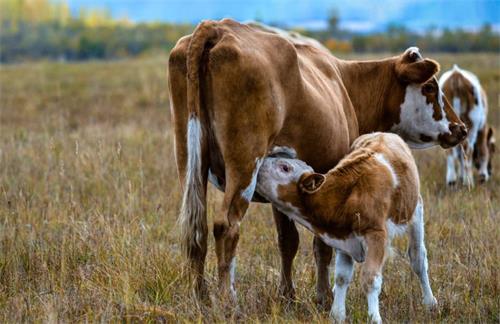As any cattle breeder knows, fertility isn’t just a reproductive trait—it’s a cornerstone of economic success. When a cow fails to cycle on time or doesn't conceive after multiple inseminations, frustration quickly sets in. Among the more subtle causes of subfertility is delayed follicle development—a condition that often goes unnoticed until it's too late. Fortunately, ultrasound has become a game-changer, offering real-time insights into ovarian dynamics and helping identify cows that are out of sync with normal follicular patterns.

What Delayed Follicle Development Looks Like
In healthy cycling cows, follicle growth follows a fairly predictable rhythm. Dominant follicles emerge, mature, and either ovulate or regress as part of a wave-like pattern. But in subfertile cows, this rhythm is often disrupted. Follicles may grow too slowly, fail to reach ovulatory size, or persist without releasing an egg. This throws off breeding schedules, extends calving intervals, and chips away at farm productivity.
On our farm, we've had heifers with excellent body condition and genetics, yet no signs of estrus. In such cases, we’ve turned to ultrasound—specifically transrectal real-time B-mode ultrasound—to observe the ovarian structures. More often than not, we spot underdeveloped follicles or signs of anovulation that would otherwise be impossible to detect through external observation or hormone monitoring alone.
Real-Time Monitoring of Ovarian Activity
One of the biggest advantages of ultrasound is its ability to provide immediate, visual confirmation of ovarian status. Using a linear probe with frequencies between 5 to 7.5 MHz, we can view follicular development over several days and identify the growth rate of each follicular wave.
In a typical scan, follicles show up as black (anechoic) circles within the ovary. A healthy dominant follicle often exceeds 10 mm in diameter before ovulation. But in subfertile cows, follicles may plateau at 6–8 mm, never reaching the size required to trigger a luteinizing hormone (LH) surge.
By tracking these measurements daily or every other day, we can classify whether the issue is a delayed growth rate, follicular persistence, or a complete absence of new waves. Each condition demands a different approach—from adjusting nutrition to modifying synchronization protocols.
Causes Behind the Delay
Delayed follicle development isn’t caused by a single factor. More often, it’s a perfect storm of subtle imbalances. Nutritional deficiencies—particularly in energy and protein—can impact GnRH (gonadotropin-releasing hormone) secretion, reducing FSH and LH pulses necessary for follicle growth. Heat stress is another big one, especially in summer months, when body temperature regulation takes priority over reproduction.
There’s also increasing research into the effect of postpartum uterine health on follicular activity. Cows with lingering endometritis or incomplete uterine involution tend to have less consistent follicular waves and lower fertility outcomes. Ultrasound helps identify these uterine conditions early, preventing long-term reproductive setbacks.
Why Timing Matters
In AI (artificial insemination) programs, success depends heavily on accurately predicting ovulation. When follicles develop at a slower rate, standard fixed-time AI schedules can miss the window entirely. That’s where real-time follicular monitoring becomes critical.
We’ve used ultrasound to track cows in synchronization programs and noticed a consistent pattern: subfertile cows often show delayed ovulation, even when administered timed hormones. By using ultrasound 24 hours before AI, we can decide whether to proceed or delay the insemination based on follicle size and structure. This flexibility has significantly improved conception rates on our farm.
Combining Ultrasound With Hormone Profiles
While ultrasound is powerful on its own, it’s even more effective when combined with blood progesterone or estrogen testing. A low progesterone level combined with a small, non-dominant follicle on ultrasound usually signals an anovulatory cycle. On the other hand, a mature follicle with rising estrogen levels suggests the cow is nearing ovulation—even if she’s showing no external signs of heat.
In one case, a first-lactation cow had no estrus signs three weeks post-calving. Ultrasound showed a 7 mm follicle that hadn’t changed size over several days. Blood testing confirmed low estrogen. Based on these findings, we revised her diet and gave a GnRH injection. Ten days later, she had a 12 mm follicle and conceived after AI.
Ultrasound for Monitoring Treatment Response
Treating delayed follicle development isn’t a one-shot deal. It often takes several cycles of nutritional changes, hormone therapy, and close monitoring. With ultrasound, we’re able to track how well a cow responds to these interventions.
If we induce ovulation with hCG or GnRH, we can check two to three days later to confirm that the follicle has collapsed and a corpus luteum (CL) has formed. No CL? That means no ovulation—and we’re back to reevaluating our strategy. This level of precision has saved us from wasting time and semen on cows that weren't biologically ready.
Lessons from the Field
In speaking with other cattle farmers and vets in the U.S., Australia, and the U.K., a common theme comes up: ultrasound is no longer just a diagnostic tool—it’s a management tool. Whether in large dairies or small family-run operations, producers are integrating ultrasound into weekly reproductive checks, especially for cows flagged as repeat breeders.
In Europe, where animal welfare regulations are strict and hormone use is more limited, ultrasound serves as a humane, data-driven alternative to aggressive synchronization. In the U.S., it's often paired with genomic selection to evaluate fertility traits at both the ovarian and genetic level.
Why It Works on Subfertile Herds
If you're managing a herd with a history of reproductive issues, ultrasound helps answer the “why” behind the numbers. Instead of guessing why certain cows fall behind, you're seeing the biology in action. For us, that has meant identifying cows with recurring follicular cysts, chronic uterine infections, or simply late bloomers who need a longer prep period post-calving.
It also helps with culling decisions. After multiple failed cycles and confirmed follicular failure, it may be more cost-effective to remove a cow from the breeding program rather than keep investing in treatments that won’t pay off.
Practical Tips for Getting Started
If you're considering using ultrasound to monitor follicular development, here are a few tips from our experience:
Use a high-frequency linear probe: You'll need clarity and resolution to track small follicular changes.
Scan consistently: Try to evaluate the same cow every 24 to 48 hours to track follicle growth rate.
Record everything: Keep notes on follicle diameter, appearance, and uterine tone.
Combine with hormone data when possible: This provides a fuller picture of reproductive status.
Don’t rely on estrus signs alone: Many subfertile cows are silent ovulators. Let the scan tell the story.
A Smarter Way Forward
Subfertility is one of the most costly and frustrating challenges in cattle reproduction. But it’s also one of the most solvable—if you have the right tools. Ultrasound allows us to catch reproductive problems early, treat them more effectively, and make better decisions for the future of the herd.
With regular use, ultrasound isn't just something you pull out when there's a problem—it becomes part of your daily or weekly management routine. And for cows struggling with delayed follicle development, that early attention might make all the difference between a successful pregnancy and another missed opportunity.
tags: Cow Follicle Development


